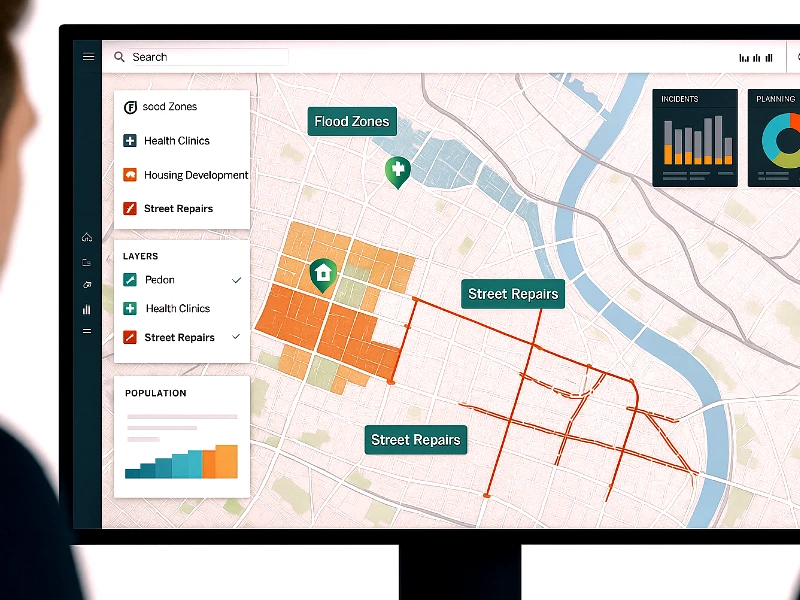In the current competitive landscape, organisations aim to increase productivity and profitability through automation. Since developing affordable computer technologies, many organisations have automated processes using tools like desktop word processing, electronic spreadsheets, relational databases, and computer-aided design systems. Modern businesses focus on boosting efficiency and cutting expenses by eliminating redundancy, reducing duplication of effort, and enhancing service delivery through cross-departmental sharing and analysis of shared information and resources.
Geographic information systems (GIS) can significantly aid the management of geographically related information. GIS facilitates innovative information organisation, allowing for discoveries and optimising the use of already-existing data. It connects specific geographic areas and relevant data, enabling the development of maps and novel analytical techniques. GIS is necessary for enhancing productivity, efficiency, and service delivery in federal, state, and local government organisations since numerous policies and procedures rely on precise, location-based information.
Ready to Implement GIS for Smarter Decisions?
Improve efficiency, accuracy, and planning with a tailored GIS solution. Let GIS Navigator guide your implementation!
📞 Schedule a Call | 📩 Email Us | 💼 Get a Quote Now
Geographic Information Systems (GIS) are fundamental tools for learning geography. These systems, which consist of hardware and a database engine, efficiently assemble, store, update, manipulate, and display geographically referenced information (data identifiable by their locations). Thus, GIS promotes a spatial or geographical way of thinking. A digital map container is just one aspect of a GIS. A spatial decision-support system is called a GIS.
GIS Implementation Strategies

A strategic strategy suited to the objectives and demands of the organisation is necessary for the effective use of GIS. The following are some essential tactics for a GIS implementation that works:
Needs Assessment
- Identify Objectives: Define what you aim to achieve with the GIS implementation.
- Stakeholder Engagement: Engage with stakeholders to understand their needs and requirements.
- Gap Analysis: Identify gaps between current capabilities and desired outcomes.
System Design and Architecture
- Data Model Design: Develop a data model that supports the intended applications.
- Technology Selection: Choose appropriate hardware, software, and platforms.
- Scalability Planning: Ensure the system can grow with increasing data and user demands.
Data Acquisition and Management
- Data Collection: Determine the sources and methods for collecting data.
- Data Quality Assurance: Implement processes to ensure data accuracy and consistency.
- Metadata Management: Create and maintain metadata for data sets.
Integration and Interoperability
- System Integration: Ensure the GIS integrates seamlessly with existing systems.
- Data Interoperability: Implement standards and protocols for data exchange between different systems.
Training and Capacity Building
- User Training: Provide training sessions for users at different levels.
- Technical Support: Establish a support system for troubleshooting and assistance.
- Continuous Learning: Promote ongoing learning and professional development.
Monitoring and Evaluation
- Performance Metrics: Establish key performance indicators (KPIs) to measure system performance.
- User Feedback: Regularly collect feedback from users to identify areas for improvement.
- Audit and Review: Conduct periodic audits and reviews to ensure the system functions as intended.
Don’t wait any longer! Start implementing GIS in your business today with expert support from our team.
Steps to Implement GIS
Planning (GIS Project Planning and Management)
- Project Initiation: Define the scope, objectives, and deliverables of the GIS project as part of comprehensive GIS project planning.
Feasibility Study: Assess the technical, financial, and operational feasibility of the project.
Project Plan: Develop a detailed project plan outlining tasks, timelines, resources, and budget to support effective GIS project management and execution.
Data Collection
- Source Identification: Identify sources of existing data and gaps where new data is needed.
- Data Gathering: Collect data through surveys, remote sensing, digitization, and other methods.
- Data Validation: Validate and verify the accuracy of collected data.
Data Processing
- Data Entry: Input collected data into the GIS system.
- Data Cleaning: Correct errors, remove duplicates, and standardize data formats.
- Data Transformation: Convert data into the required GIS formats and coordinate systems.
System Setup
- Software Installation: Install and configure GIS software.
- Database Creation: Set up the GIS database and define the data structure.
- Customization: Customize the GIS application to meet specific user requirements.
Data Integration
- Import Data: Import existing data into the GIS system.
- Link External Data: Establish connections with external data sources and databases.
- Data Merging: Integrate different datasets to create a comprehensive database.
Application Development
- Tool Development: Develop tools and applications as part of the wider GIS development process to support data analysis, visualisation, and decision-making.
- User Interface Design: Design user-friendly interfaces for different types of users.
- Testing: Conduct thorough testing to ensure the system works as expected.
Training and Support
- User Training: Conduct training sessions for users and administrators.
- Documentation: Provide user manuals, guides, and help documentation.
- Help Desk: Set up a help desk or support center for ongoing assistance.
Deployment
- Pilot Testing: Implement a pilot phase to test the system in a controlled environment.
- Full Rollout: Deploy the system organization-wide based on pilot feedback.
- Change Management: Manage the transition to the new system, addressing any resistance or issues.
Explore: What is GIS mapping?
Challenges in GIS Implementation

As everyone knows, GIS links data to analyse and visualise spatial information from various sources, including databases, map tiles, and satellite imagery. It analyses geographic data to produce maps, spot trends, and make wise judgments.
Technical difficulties, the demand for integration into current workflows, and the need for interdisciplinary cooperation all contribute to the complexity of implementing a GIS system.
The way technology and spatial data are developing worsens these challenges. Careful planning and continual assessment are crucial to overcome these obstacles and guarantee the successful adoption of GIS.
Data Integration
Creating a coherent GIS database requires coordination to integrate diverse datasets and handle different patterns, resolutions, and accuracy levels. This procedure ensures that the many data sources are integrated into a single, cohesive system, facilitating more precise and thorough analysis.
Quality Assurance
Using methodical validation, verification, and quality control procedures, QA guarantees the dependability and usability of GIS data. Robust data validation procedures, error detection systems, and a data quality monitoring framework are needed to find and fix anomalies or inconsistencies.
Software Selection
Along with thorough idea evaluations, the process includes extensive software evaluations that consider many aspects, such as functionality, performance, scalability, extensibility, vendor support, and licensing models.
Infrastructure
The networking, computing, and storage requirements of geospatial processing and analytic tasks must be addressed to provide a scalable and resilient GIS infrastructure. This allows the system to support dependable and effective geographic data administration and analysis by guaranteeing its ability to withstand growing demands, sustain performance, and bounce back from errors.
Compatibility
Resolving inconsistent data formats, putting standardised data exchange protocols (like OGC standards) in place, employing middleware for data translation and mediation, and ensuring that integration with current enterprise systems and workflows is seamless.
Scalability
Architecting GIS systems involves:
- Accommodating increasing data volumes.
- Supporting high user concurrency.
- Managing demanding computational workloads.
- Ensuring optimal performance levels.
- Maintaining resource utilization efficiency.
Maximize the Value of GIS for Your Business
Turn geographic data into actionable insights with a smooth GIS setup. Consult GIS Navigator for a successful implementation!
📞 Schedule a Call | 📩 Email Us | 💼 Get a Quote Now
Conclusion
Implementing a GIS project requires thorough planning, efficient project management, and handling several obstacles. Organisations can use GIS to improve decision-making, increase efficiency, and accomplish their goals by adhering to the procedures and techniques provided. Recall that an adequately installed GIS may revolutionise how your company operates and offer insightful data to help you make better decisions.
Transform your organisation’s efficiency and decision-making with GIS Navigator, a top GIS mapping company that offers expert GIS mapping services that can revolutionize your operations.
Whether you’re starting with foundational GIS project planning or scaling up to full enterprise GIS development, our team ensures smooth implementation and measurable results.



